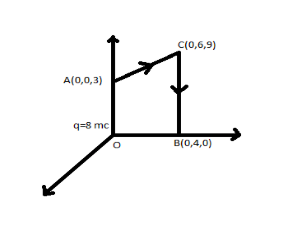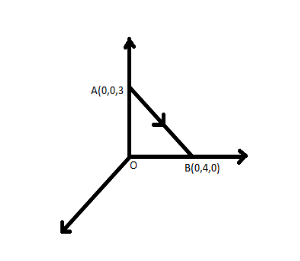Question
Question: Calculate the work done in taking a charge \( - 2 \times {10^{ - 9}}C\) from A and B via C (in diagr...
Calculate the work done in taking a charge −2×10−9C from A and B via C (in diagram).

A. 0.2 J
B. 1.2 J
C. 2.2 J
D. Zero
Solution
To calculate the work done in moving the charge from point A to point B firstly, calculate the potential at the point A and B respectively. Then, calculate the potential difference between the point A and B created due to charge present at the origin. At last multiply the calculated potential difference with the charge moving from point A and B.
Formula used : W=q1(VB−VA)
Here, q1 is the charge which moves. VB is the potential at B due to q and VA is the potential at A due to q.
Complete step by step answer:
In this question, we want to find out the work done in bringing a charge −2×10−9C from A to B via C. But as we know that moving a charge in electric field is independent of path chosen to move the charge in electric field and depends only on electric potential difference between them.

If charge directly moves from A to B then the result will be the same.

The only thing we need to do is to find the potential at A due to charge q=8mc at the origin i.e., .
rOA= Distance between origin and the point A=3cm.
Similarly, potential at B due to charge, q=8mcat the origin
rOB= Distance between origin and the point B=4cm.
∴workdone=q1(VB−VA)
Now, by substituting the values we get,
Now, putting all the values,
q1=−2×10−9C
q=8mc=8×10−3C
rOB=4cm
rOA=3cm
W=−2×10−9×8×10−3×9×109(41−31)
∴W=1.27 J (Answer)
Note: Charge which is moving from one point to another is always multiplied to potential difference between the points, whatever the path of charge will be.
